Analyzing Health Workforce Policies: Australia and China Comparison
VerifiedAdded on 2023/06/11
|14
|3084
|429
Report
AI Summary
This report provides a comparative analysis of health workforce policies in Australia and China, two prominent nations in the WHO Western Pacific Region. It examines the environmental scan of the health workforce in both countries, highlighting disparities between rural and urban areas, workforce supply fluctuations, and the role of international medical graduates. The report identifies critical issues such as gender distribution, economic disparity, and the integration of technology in healthcare. Furthermore, it assesses the adherence of both nations to WHO priorities, including gender equality and human rights. The analysis covers policies related to private medical practices, herbal medicine legalization in China, and community-based health systems. The report concludes by emphasizing the need for continued efforts to address workforce disparities, promote innovation, and ensure compliance with global health standards. Desklib offers this and many other resources to aid students in their studies.
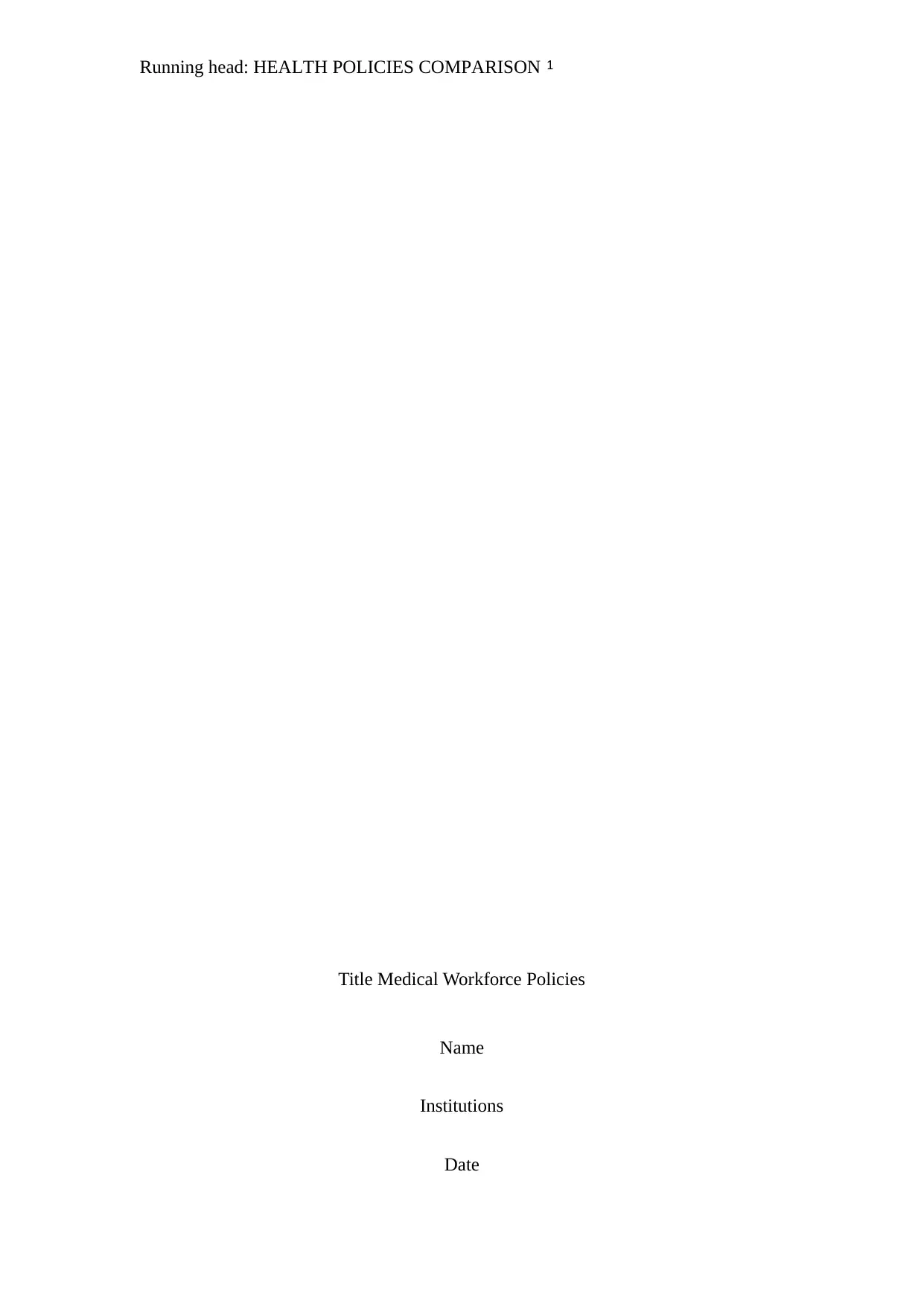
1Running head: HEALTH POLICIES COMPARISON
Title Medical Workforce Policies
Name
Institutions
Date
Title Medical Workforce Policies
Name
Institutions
Date
Paraphrase This Document
Need a fresh take? Get an instant paraphrase of this document with our AI Paraphraser
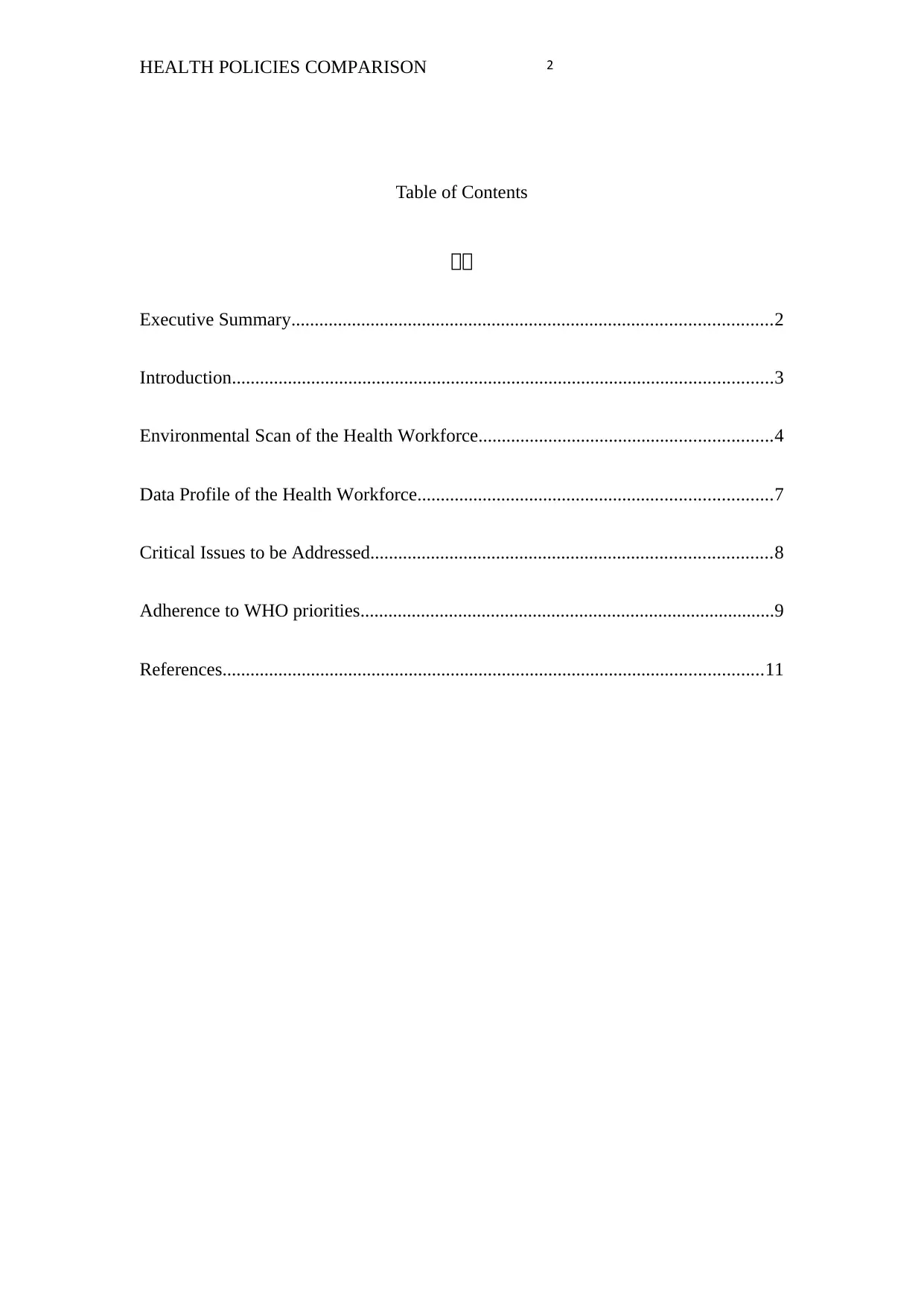
2HEALTH POLICIES COMPARISON
Table of Contents
目目
Executive Summary.......................................................................................................2
Introduction....................................................................................................................3
Environmental Scan of the Health Workforce...............................................................4
Data Profile of the Health Workforce............................................................................7
Critical Issues to be Addressed......................................................................................8
Adherence to WHO priorities.........................................................................................9
References....................................................................................................................11
Table of Contents
目目
Executive Summary.......................................................................................................2
Introduction....................................................................................................................3
Environmental Scan of the Health Workforce...............................................................4
Data Profile of the Health Workforce............................................................................7
Critical Issues to be Addressed......................................................................................8
Adherence to WHO priorities.........................................................................................9
References....................................................................................................................11
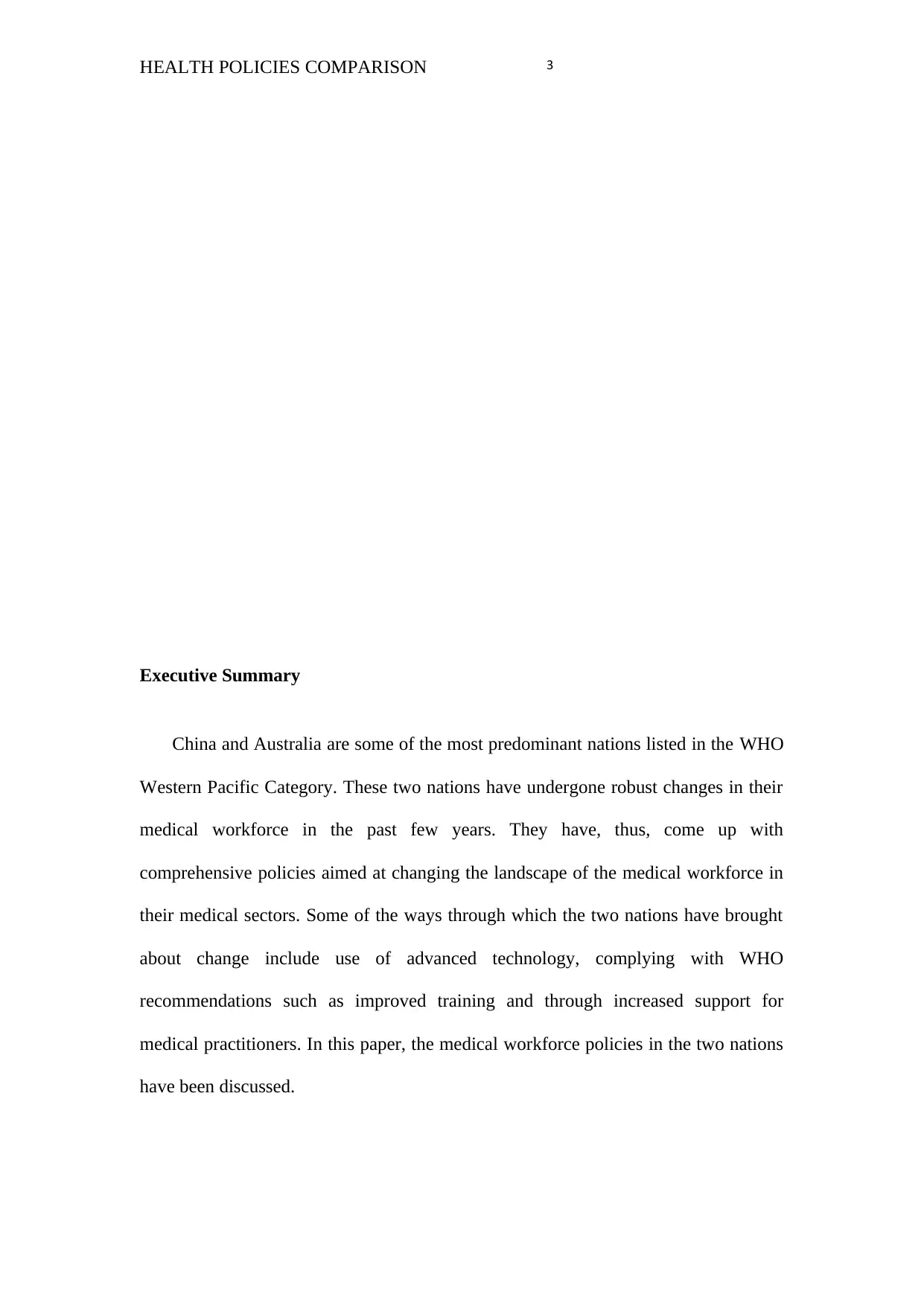
3HEALTH POLICIES COMPARISON
Executive Summary
China and Australia are some of the most predominant nations listed in the WHO
Western Pacific Category. These two nations have undergone robust changes in their
medical workforce in the past few years. They have, thus, come up with
comprehensive policies aimed at changing the landscape of the medical workforce in
their medical sectors. Some of the ways through which the two nations have brought
about change include use of advanced technology, complying with WHO
recommendations such as improved training and through increased support for
medical practitioners. In this paper, the medical workforce policies in the two nations
have been discussed.
Executive Summary
China and Australia are some of the most predominant nations listed in the WHO
Western Pacific Category. These two nations have undergone robust changes in their
medical workforce in the past few years. They have, thus, come up with
comprehensive policies aimed at changing the landscape of the medical workforce in
their medical sectors. Some of the ways through which the two nations have brought
about change include use of advanced technology, complying with WHO
recommendations such as improved training and through increased support for
medical practitioners. In this paper, the medical workforce policies in the two nations
have been discussed.
⊘ This is a preview!⊘
Do you want full access?
Subscribe today to unlock all pages.

Trusted by 1+ million students worldwide
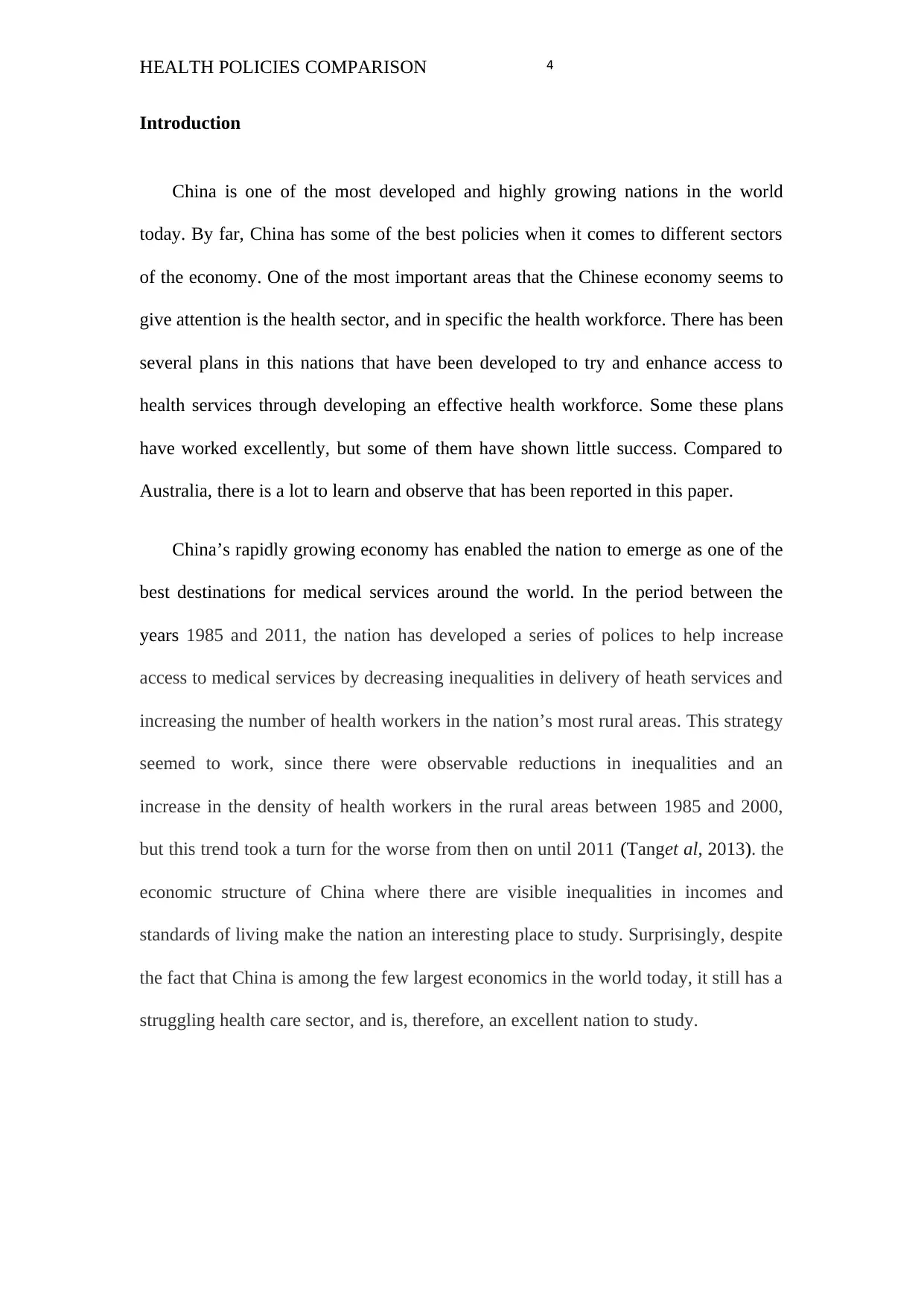
4HEALTH POLICIES COMPARISON
Introduction
China is one of the most developed and highly growing nations in the world
today. By far, China has some of the best policies when it comes to different sectors
of the economy. One of the most important areas that the Chinese economy seems to
give attention is the health sector, and in specific the health workforce. There has been
several plans in this nations that have been developed to try and enhance access to
health services through developing an effective health workforce. Some these plans
have worked excellently, but some of them have shown little success. Compared to
Australia, there is a lot to learn and observe that has been reported in this paper.
China’s rapidly growing economy has enabled the nation to emerge as one of the
best destinations for medical services around the world. In the period between the
years 1985 and 2011, the nation has developed a series of polices to help increase
access to medical services by decreasing inequalities in delivery of heath services and
increasing the number of health workers in the nation’s most rural areas. This strategy
seemed to work, since there were observable reductions in inequalities and an
increase in the density of health workers in the rural areas between 1985 and 2000,
but this trend took a turn for the worse from then on until 2011 (Tanget al, 2013). the
economic structure of China where there are visible inequalities in incomes and
standards of living make the nation an interesting place to study. Surprisingly, despite
the fact that China is among the few largest economics in the world today, it still has a
struggling health care sector, and is, therefore, an excellent nation to study.
Introduction
China is one of the most developed and highly growing nations in the world
today. By far, China has some of the best policies when it comes to different sectors
of the economy. One of the most important areas that the Chinese economy seems to
give attention is the health sector, and in specific the health workforce. There has been
several plans in this nations that have been developed to try and enhance access to
health services through developing an effective health workforce. Some these plans
have worked excellently, but some of them have shown little success. Compared to
Australia, there is a lot to learn and observe that has been reported in this paper.
China’s rapidly growing economy has enabled the nation to emerge as one of the
best destinations for medical services around the world. In the period between the
years 1985 and 2011, the nation has developed a series of polices to help increase
access to medical services by decreasing inequalities in delivery of heath services and
increasing the number of health workers in the nation’s most rural areas. This strategy
seemed to work, since there were observable reductions in inequalities and an
increase in the density of health workers in the rural areas between 1985 and 2000,
but this trend took a turn for the worse from then on until 2011 (Tanget al, 2013). the
economic structure of China where there are visible inequalities in incomes and
standards of living make the nation an interesting place to study. Surprisingly, despite
the fact that China is among the few largest economics in the world today, it still has a
struggling health care sector, and is, therefore, an excellent nation to study.
Paraphrase This Document
Need a fresh take? Get an instant paraphrase of this document with our AI Paraphraser
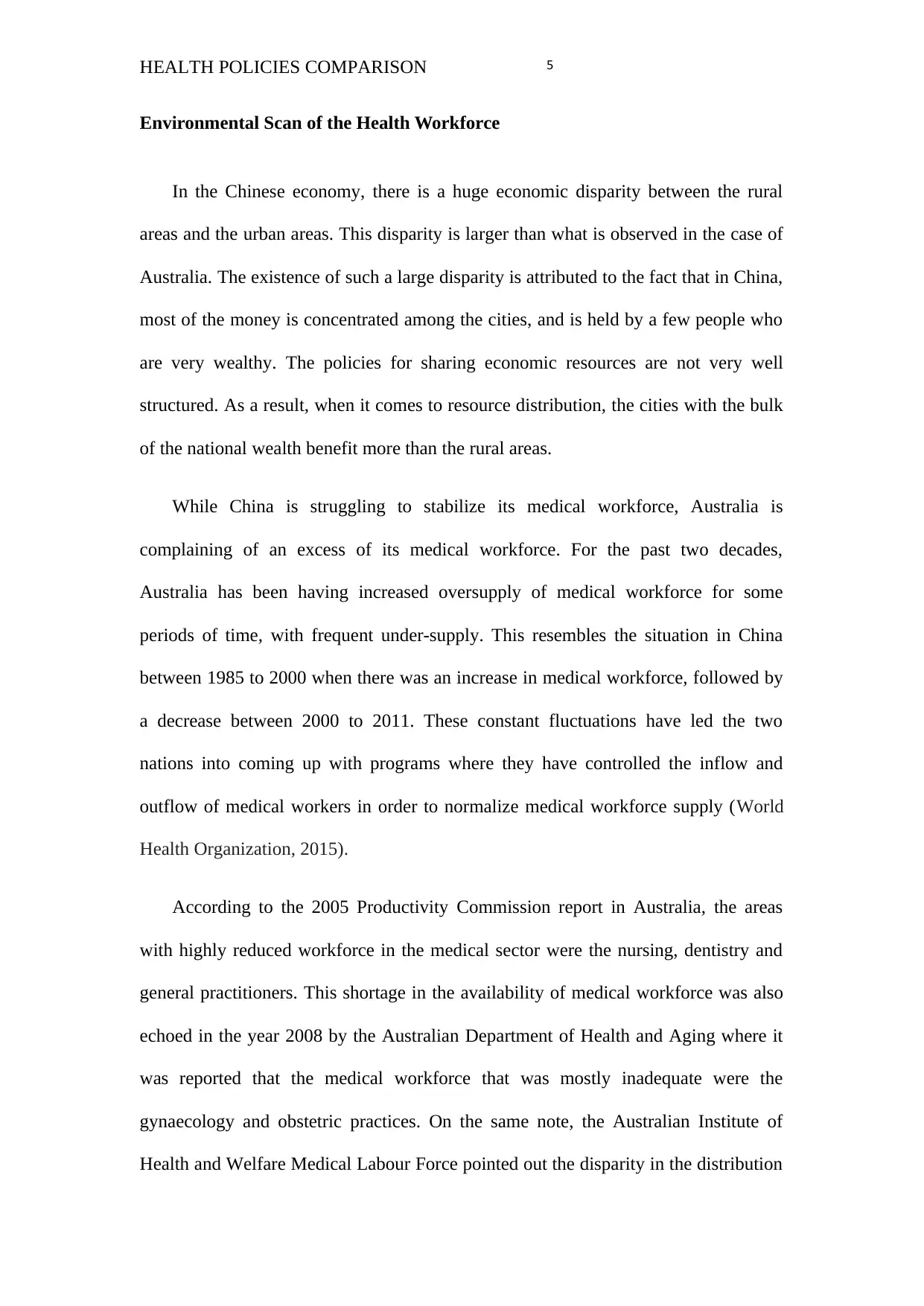
5HEALTH POLICIES COMPARISON
Environmental Scan of the Health Workforce
In the Chinese economy, there is a huge economic disparity between the rural
areas and the urban areas. This disparity is larger than what is observed in the case of
Australia. The existence of such a large disparity is attributed to the fact that in China,
most of the money is concentrated among the cities, and is held by a few people who
are very wealthy. The policies for sharing economic resources are not very well
structured. As a result, when it comes to resource distribution, the cities with the bulk
of the national wealth benefit more than the rural areas.
While China is struggling to stabilize its medical workforce, Australia is
complaining of an excess of its medical workforce. For the past two decades,
Australia has been having increased oversupply of medical workforce for some
periods of time, with frequent under-supply. This resembles the situation in China
between 1985 to 2000 when there was an increase in medical workforce, followed by
a decrease between 2000 to 2011. These constant fluctuations have led the two
nations into coming up with programs where they have controlled the inflow and
outflow of medical workers in order to normalize medical workforce supply (World
Health Organization, 2015).
According to the 2005 Productivity Commission report in Australia, the areas
with highly reduced workforce in the medical sector were the nursing, dentistry and
general practitioners. This shortage in the availability of medical workforce was also
echoed in the year 2008 by the Australian Department of Health and Aging where it
was reported that the medical workforce that was mostly inadequate were the
gynaecology and obstetric practices. On the same note, the Australian Institute of
Health and Welfare Medical Labour Force pointed out the disparity in the distribution
Environmental Scan of the Health Workforce
In the Chinese economy, there is a huge economic disparity between the rural
areas and the urban areas. This disparity is larger than what is observed in the case of
Australia. The existence of such a large disparity is attributed to the fact that in China,
most of the money is concentrated among the cities, and is held by a few people who
are very wealthy. The policies for sharing economic resources are not very well
structured. As a result, when it comes to resource distribution, the cities with the bulk
of the national wealth benefit more than the rural areas.
While China is struggling to stabilize its medical workforce, Australia is
complaining of an excess of its medical workforce. For the past two decades,
Australia has been having increased oversupply of medical workforce for some
periods of time, with frequent under-supply. This resembles the situation in China
between 1985 to 2000 when there was an increase in medical workforce, followed by
a decrease between 2000 to 2011. These constant fluctuations have led the two
nations into coming up with programs where they have controlled the inflow and
outflow of medical workers in order to normalize medical workforce supply (World
Health Organization, 2015).
According to the 2005 Productivity Commission report in Australia, the areas
with highly reduced workforce in the medical sector were the nursing, dentistry and
general practitioners. This shortage in the availability of medical workforce was also
echoed in the year 2008 by the Australian Department of Health and Aging where it
was reported that the medical workforce that was mostly inadequate were the
gynaecology and obstetric practices. On the same note, the Australian Institute of
Health and Welfare Medical Labour Force pointed out the disparity in the distribution
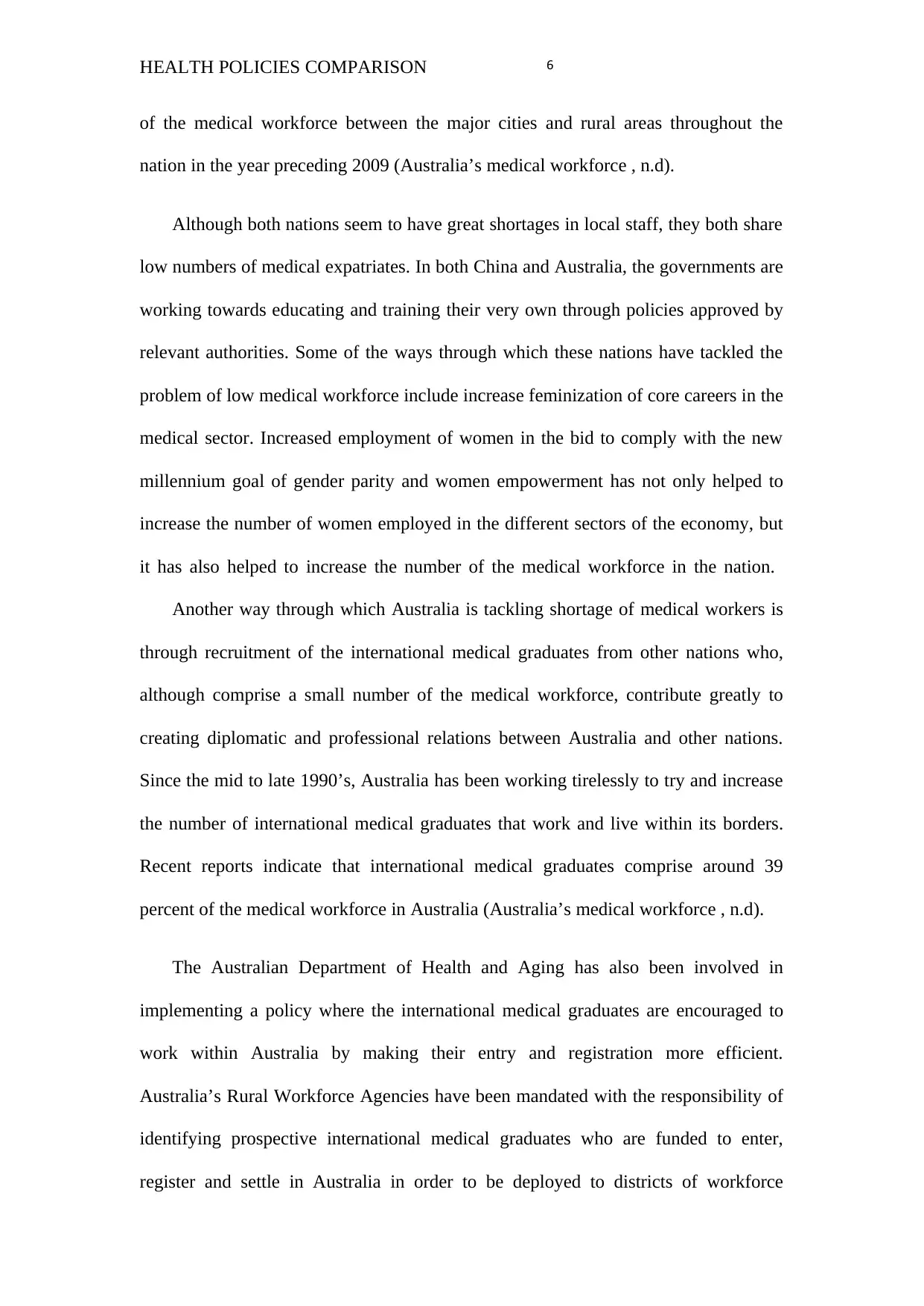
6HEALTH POLICIES COMPARISON
of the medical workforce between the major cities and rural areas throughout the
nation in the year preceding 2009 (Australia’s medical workforce , n.d).
Although both nations seem to have great shortages in local staff, they both share
low numbers of medical expatriates. In both China and Australia, the governments are
working towards educating and training their very own through policies approved by
relevant authorities. Some of the ways through which these nations have tackled the
problem of low medical workforce include increase feminization of core careers in the
medical sector. Increased employment of women in the bid to comply with the new
millennium goal of gender parity and women empowerment has not only helped to
increase the number of women employed in the different sectors of the economy, but
it has also helped to increase the number of the medical workforce in the nation.
Another way through which Australia is tackling shortage of medical workers is
through recruitment of the international medical graduates from other nations who,
although comprise a small number of the medical workforce, contribute greatly to
creating diplomatic and professional relations between Australia and other nations.
Since the mid to late 1990’s, Australia has been working tirelessly to try and increase
the number of international medical graduates that work and live within its borders.
Recent reports indicate that international medical graduates comprise around 39
percent of the medical workforce in Australia (Australia’s medical workforce , n.d).
The Australian Department of Health and Aging has also been involved in
implementing a policy where the international medical graduates are encouraged to
work within Australia by making their entry and registration more efficient.
Australia’s Rural Workforce Agencies have been mandated with the responsibility of
identifying prospective international medical graduates who are funded to enter,
register and settle in Australia in order to be deployed to districts of workforce
of the medical workforce between the major cities and rural areas throughout the
nation in the year preceding 2009 (Australia’s medical workforce , n.d).
Although both nations seem to have great shortages in local staff, they both share
low numbers of medical expatriates. In both China and Australia, the governments are
working towards educating and training their very own through policies approved by
relevant authorities. Some of the ways through which these nations have tackled the
problem of low medical workforce include increase feminization of core careers in the
medical sector. Increased employment of women in the bid to comply with the new
millennium goal of gender parity and women empowerment has not only helped to
increase the number of women employed in the different sectors of the economy, but
it has also helped to increase the number of the medical workforce in the nation.
Another way through which Australia is tackling shortage of medical workers is
through recruitment of the international medical graduates from other nations who,
although comprise a small number of the medical workforce, contribute greatly to
creating diplomatic and professional relations between Australia and other nations.
Since the mid to late 1990’s, Australia has been working tirelessly to try and increase
the number of international medical graduates that work and live within its borders.
Recent reports indicate that international medical graduates comprise around 39
percent of the medical workforce in Australia (Australia’s medical workforce , n.d).
The Australian Department of Health and Aging has also been involved in
implementing a policy where the international medical graduates are encouraged to
work within Australia by making their entry and registration more efficient.
Australia’s Rural Workforce Agencies have been mandated with the responsibility of
identifying prospective international medical graduates who are funded to enter,
register and settle in Australia in order to be deployed to districts of workforce
⊘ This is a preview!⊘
Do you want full access?
Subscribe today to unlock all pages.

Trusted by 1+ million students worldwide
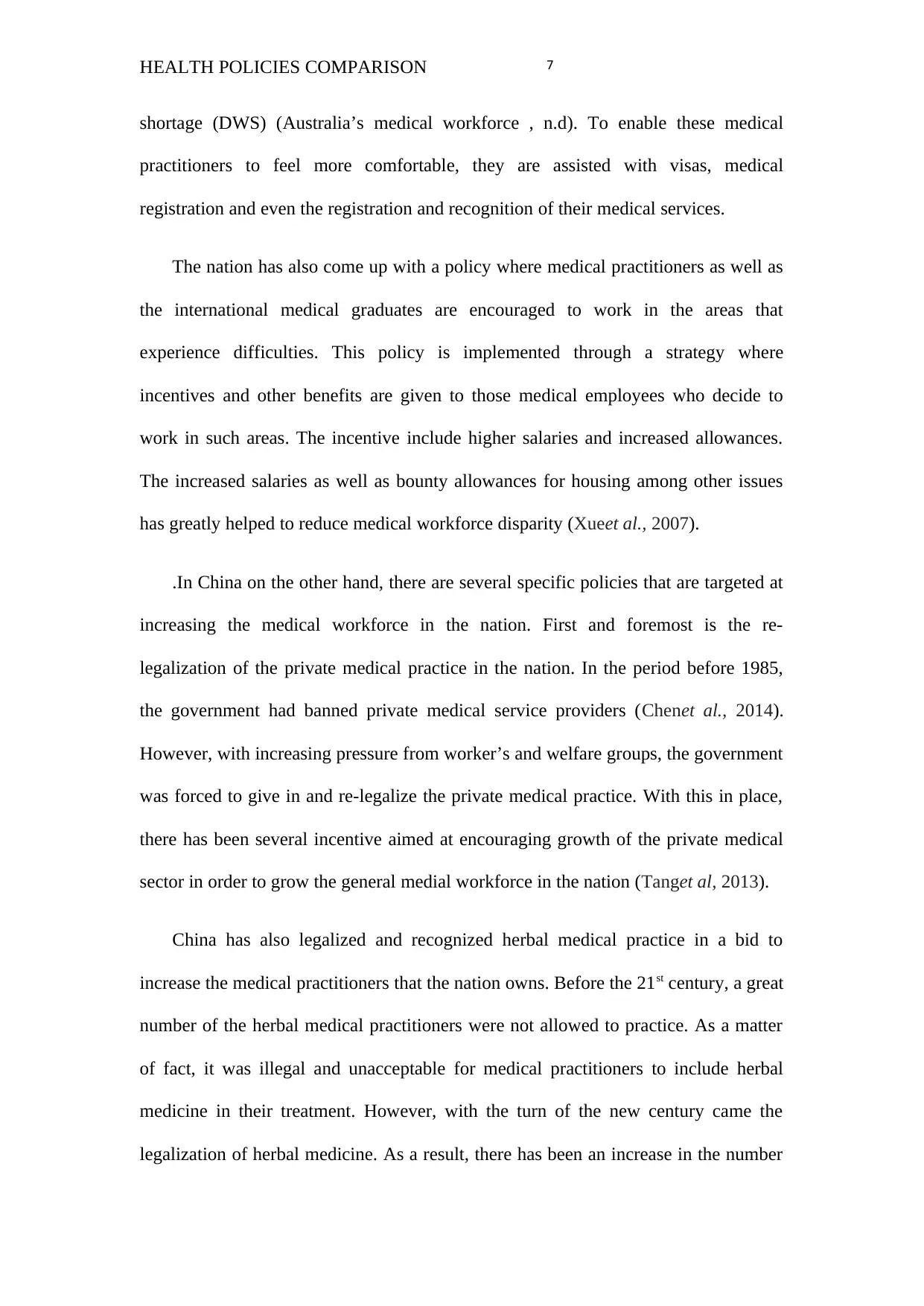
7HEALTH POLICIES COMPARISON
shortage (DWS) (Australia’s medical workforce , n.d). To enable these medical
practitioners to feel more comfortable, they are assisted with visas, medical
registration and even the registration and recognition of their medical services.
The nation has also come up with a policy where medical practitioners as well as
the international medical graduates are encouraged to work in the areas that
experience difficulties. This policy is implemented through a strategy where
incentives and other benefits are given to those medical employees who decide to
work in such areas. The incentive include higher salaries and increased allowances.
The increased salaries as well as bounty allowances for housing among other issues
has greatly helped to reduce medical workforce disparity (Xueet al., 2007).
.In China on the other hand, there are several specific policies that are targeted at
increasing the medical workforce in the nation. First and foremost is the re-
legalization of the private medical practice in the nation. In the period before 1985,
the government had banned private medical service providers (Chenet al., 2014).
However, with increasing pressure from worker’s and welfare groups, the government
was forced to give in and re-legalize the private medical practice. With this in place,
there has been several incentive aimed at encouraging growth of the private medical
sector in order to grow the general medial workforce in the nation (Tanget al, 2013).
China has also legalized and recognized herbal medical practice in a bid to
increase the medical practitioners that the nation owns. Before the 21st century, a great
number of the herbal medical practitioners were not allowed to practice. As a matter
of fact, it was illegal and unacceptable for medical practitioners to include herbal
medicine in their treatment. However, with the turn of the new century came the
legalization of herbal medicine. As a result, there has been an increase in the number
shortage (DWS) (Australia’s medical workforce , n.d). To enable these medical
practitioners to feel more comfortable, they are assisted with visas, medical
registration and even the registration and recognition of their medical services.
The nation has also come up with a policy where medical practitioners as well as
the international medical graduates are encouraged to work in the areas that
experience difficulties. This policy is implemented through a strategy where
incentives and other benefits are given to those medical employees who decide to
work in such areas. The incentive include higher salaries and increased allowances.
The increased salaries as well as bounty allowances for housing among other issues
has greatly helped to reduce medical workforce disparity (Xueet al., 2007).
.In China on the other hand, there are several specific policies that are targeted at
increasing the medical workforce in the nation. First and foremost is the re-
legalization of the private medical practice in the nation. In the period before 1985,
the government had banned private medical service providers (Chenet al., 2014).
However, with increasing pressure from worker’s and welfare groups, the government
was forced to give in and re-legalize the private medical practice. With this in place,
there has been several incentive aimed at encouraging growth of the private medical
sector in order to grow the general medial workforce in the nation (Tanget al, 2013).
China has also legalized and recognized herbal medical practice in a bid to
increase the medical practitioners that the nation owns. Before the 21st century, a great
number of the herbal medical practitioners were not allowed to practice. As a matter
of fact, it was illegal and unacceptable for medical practitioners to include herbal
medicine in their treatment. However, with the turn of the new century came the
legalization of herbal medicine. As a result, there has been an increase in the number
Paraphrase This Document
Need a fresh take? Get an instant paraphrase of this document with our AI Paraphraser
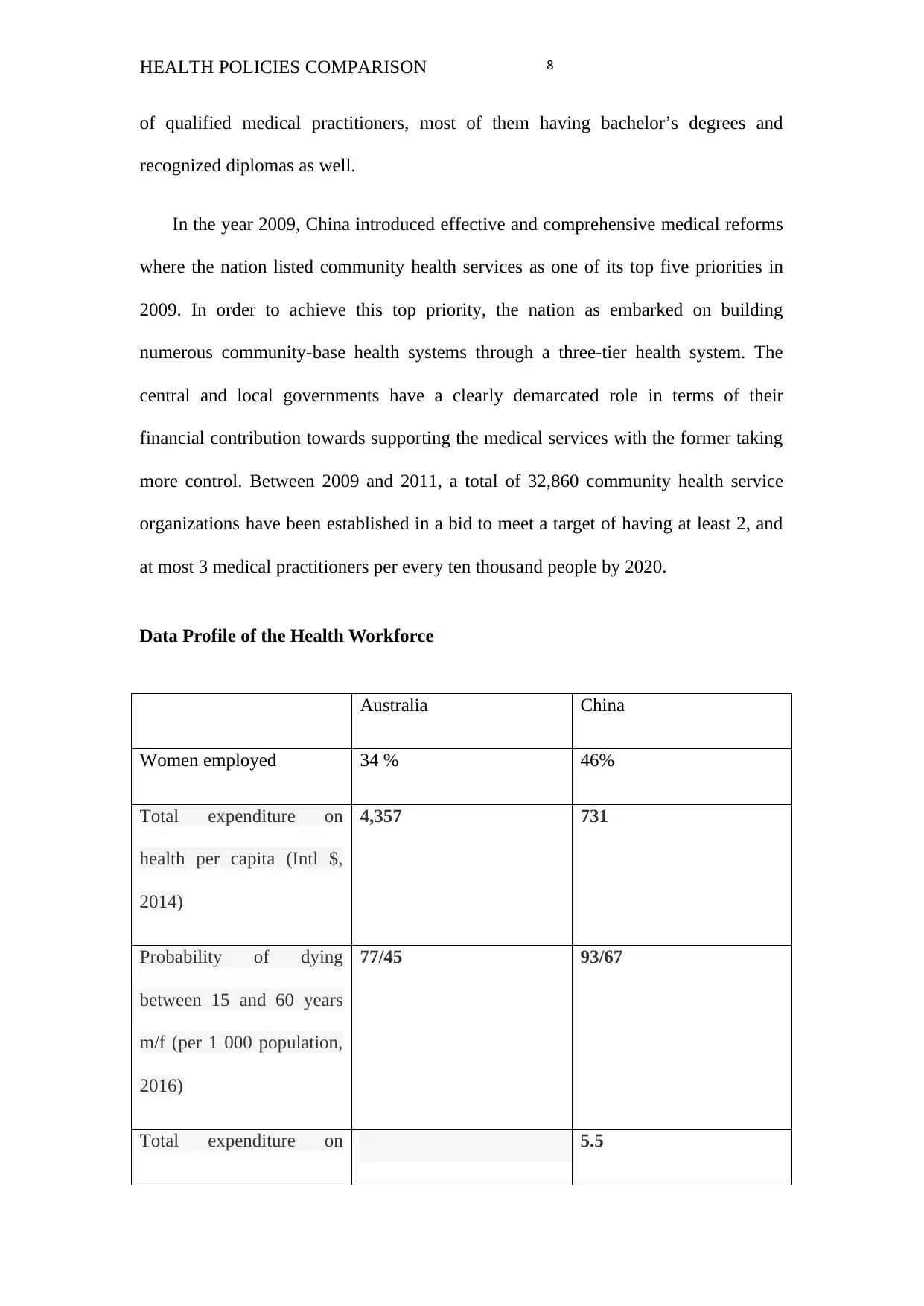
8HEALTH POLICIES COMPARISON
of qualified medical practitioners, most of them having bachelor’s degrees and
recognized diplomas as well.
In the year 2009, China introduced effective and comprehensive medical reforms
where the nation listed community health services as one of its top five priorities in
2009. In order to achieve this top priority, the nation as embarked on building
numerous community-base health systems through a three-tier health system. The
central and local governments have a clearly demarcated role in terms of their
financial contribution towards supporting the medical services with the former taking
more control. Between 2009 and 2011, a total of 32,860 community health service
organizations have been established in a bid to meet a target of having at least 2, and
at most 3 medical practitioners per every ten thousand people by 2020.
Data Profile of the Health Workforce
Australia China
Women employed 34 % 46%
Total expenditure on
health per capita (Intl $,
2014)
4,357 731
Probability of dying
between 15 and 60 years
m/f (per 1 000 population,
2016)
77/45 93/67
Total expenditure on 5.5
of qualified medical practitioners, most of them having bachelor’s degrees and
recognized diplomas as well.
In the year 2009, China introduced effective and comprehensive medical reforms
where the nation listed community health services as one of its top five priorities in
2009. In order to achieve this top priority, the nation as embarked on building
numerous community-base health systems through a three-tier health system. The
central and local governments have a clearly demarcated role in terms of their
financial contribution towards supporting the medical services with the former taking
more control. Between 2009 and 2011, a total of 32,860 community health service
organizations have been established in a bid to meet a target of having at least 2, and
at most 3 medical practitioners per every ten thousand people by 2020.
Data Profile of the Health Workforce
Australia China
Women employed 34 % 46%
Total expenditure on
health per capita (Intl $,
2014)
4,357 731
Probability of dying
between 15 and 60 years
m/f (per 1 000 population,
2016)
77/45 93/67
Total expenditure on 5.5
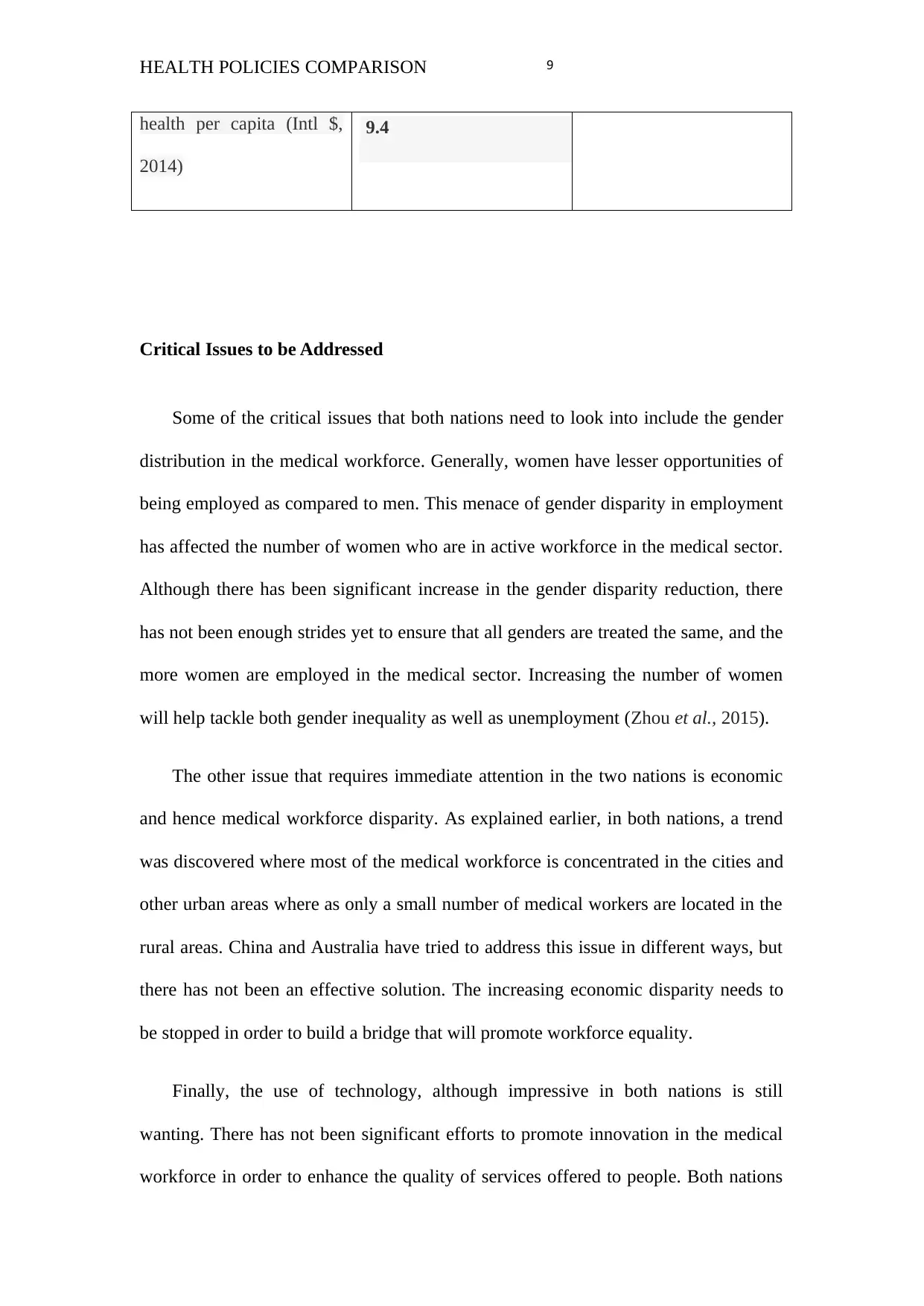
9HEALTH POLICIES COMPARISON
health per capita (Intl $,
2014)
9.4
Critical Issues to be Addressed
Some of the critical issues that both nations need to look into include the gender
distribution in the medical workforce. Generally, women have lesser opportunities of
being employed as compared to men. This menace of gender disparity in employment
has affected the number of women who are in active workforce in the medical sector.
Although there has been significant increase in the gender disparity reduction, there
has not been enough strides yet to ensure that all genders are treated the same, and the
more women are employed in the medical sector. Increasing the number of women
will help tackle both gender inequality as well as unemployment (Zhou et al., 2015).
The other issue that requires immediate attention in the two nations is economic
and hence medical workforce disparity. As explained earlier, in both nations, a trend
was discovered where most of the medical workforce is concentrated in the cities and
other urban areas where as only a small number of medical workers are located in the
rural areas. China and Australia have tried to address this issue in different ways, but
there has not been an effective solution. The increasing economic disparity needs to
be stopped in order to build a bridge that will promote workforce equality.
Finally, the use of technology, although impressive in both nations is still
wanting. There has not been significant efforts to promote innovation in the medical
workforce in order to enhance the quality of services offered to people. Both nations
health per capita (Intl $,
2014)
9.4
Critical Issues to be Addressed
Some of the critical issues that both nations need to look into include the gender
distribution in the medical workforce. Generally, women have lesser opportunities of
being employed as compared to men. This menace of gender disparity in employment
has affected the number of women who are in active workforce in the medical sector.
Although there has been significant increase in the gender disparity reduction, there
has not been enough strides yet to ensure that all genders are treated the same, and the
more women are employed in the medical sector. Increasing the number of women
will help tackle both gender inequality as well as unemployment (Zhou et al., 2015).
The other issue that requires immediate attention in the two nations is economic
and hence medical workforce disparity. As explained earlier, in both nations, a trend
was discovered where most of the medical workforce is concentrated in the cities and
other urban areas where as only a small number of medical workers are located in the
rural areas. China and Australia have tried to address this issue in different ways, but
there has not been an effective solution. The increasing economic disparity needs to
be stopped in order to build a bridge that will promote workforce equality.
Finally, the use of technology, although impressive in both nations is still
wanting. There has not been significant efforts to promote innovation in the medical
workforce in order to enhance the quality of services offered to people. Both nations
⊘ This is a preview!⊘
Do you want full access?
Subscribe today to unlock all pages.

Trusted by 1+ million students worldwide
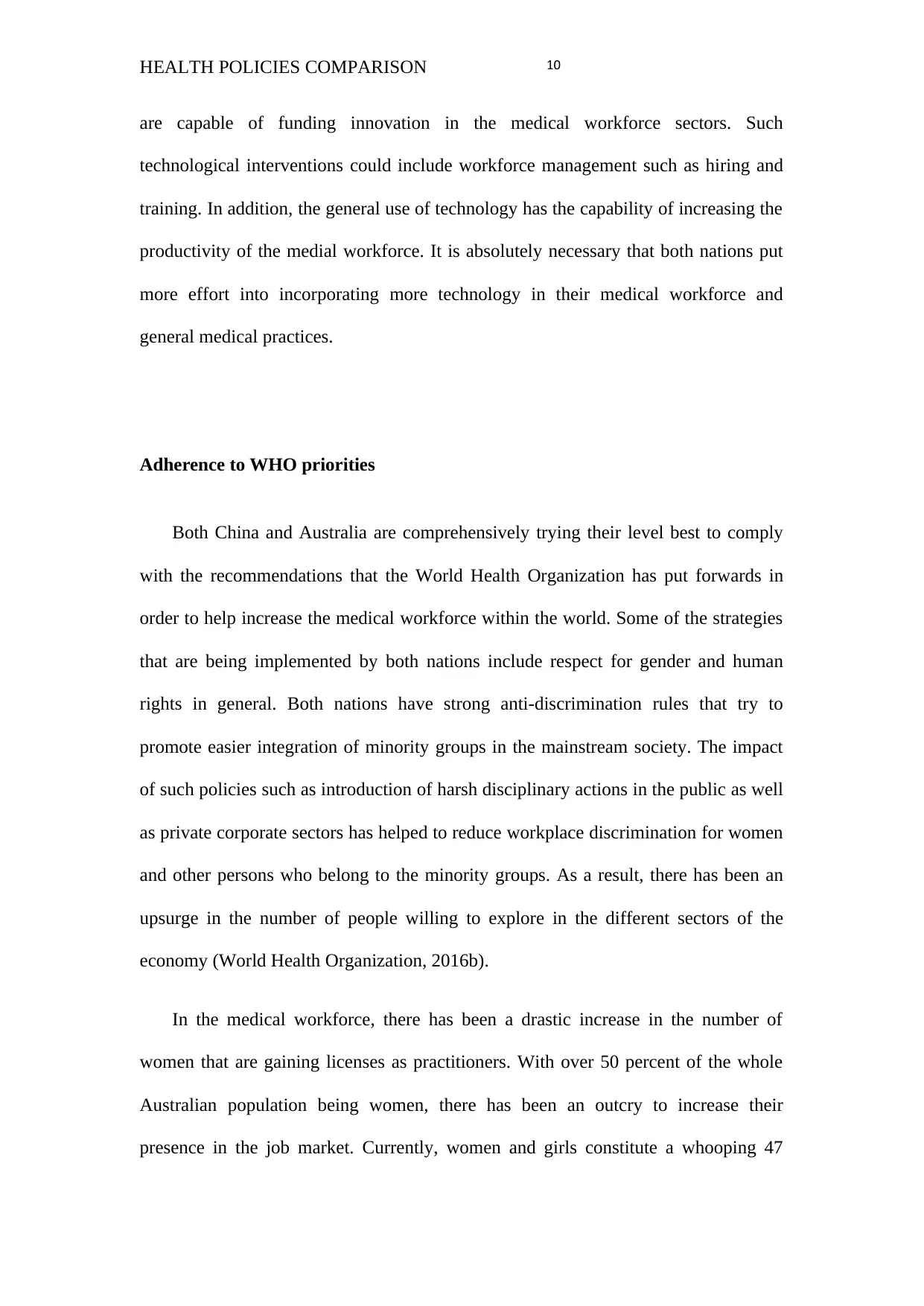
10HEALTH POLICIES COMPARISON
are capable of funding innovation in the medical workforce sectors. Such
technological interventions could include workforce management such as hiring and
training. In addition, the general use of technology has the capability of increasing the
productivity of the medial workforce. It is absolutely necessary that both nations put
more effort into incorporating more technology in their medical workforce and
general medical practices.
Adherence to WHO priorities
Both China and Australia are comprehensively trying their level best to comply
with the recommendations that the World Health Organization has put forwards in
order to help increase the medical workforce within the world. Some of the strategies
that are being implemented by both nations include respect for gender and human
rights in general. Both nations have strong anti-discrimination rules that try to
promote easier integration of minority groups in the mainstream society. The impact
of such policies such as introduction of harsh disciplinary actions in the public as well
as private corporate sectors has helped to reduce workplace discrimination for women
and other persons who belong to the minority groups. As a result, there has been an
upsurge in the number of people willing to explore in the different sectors of the
economy (World Health Organization, 2016b).
In the medical workforce, there has been a drastic increase in the number of
women that are gaining licenses as practitioners. With over 50 percent of the whole
Australian population being women, there has been an outcry to increase their
presence in the job market. Currently, women and girls constitute a whooping 47
are capable of funding innovation in the medical workforce sectors. Such
technological interventions could include workforce management such as hiring and
training. In addition, the general use of technology has the capability of increasing the
productivity of the medial workforce. It is absolutely necessary that both nations put
more effort into incorporating more technology in their medical workforce and
general medical practices.
Adherence to WHO priorities
Both China and Australia are comprehensively trying their level best to comply
with the recommendations that the World Health Organization has put forwards in
order to help increase the medical workforce within the world. Some of the strategies
that are being implemented by both nations include respect for gender and human
rights in general. Both nations have strong anti-discrimination rules that try to
promote easier integration of minority groups in the mainstream society. The impact
of such policies such as introduction of harsh disciplinary actions in the public as well
as private corporate sectors has helped to reduce workplace discrimination for women
and other persons who belong to the minority groups. As a result, there has been an
upsurge in the number of people willing to explore in the different sectors of the
economy (World Health Organization, 2016b).
In the medical workforce, there has been a drastic increase in the number of
women that are gaining licenses as practitioners. With over 50 percent of the whole
Australian population being women, there has been an outcry to increase their
presence in the job market. Currently, women and girls constitute a whooping 47
Paraphrase This Document
Need a fresh take? Get an instant paraphrase of this document with our AI Paraphraser
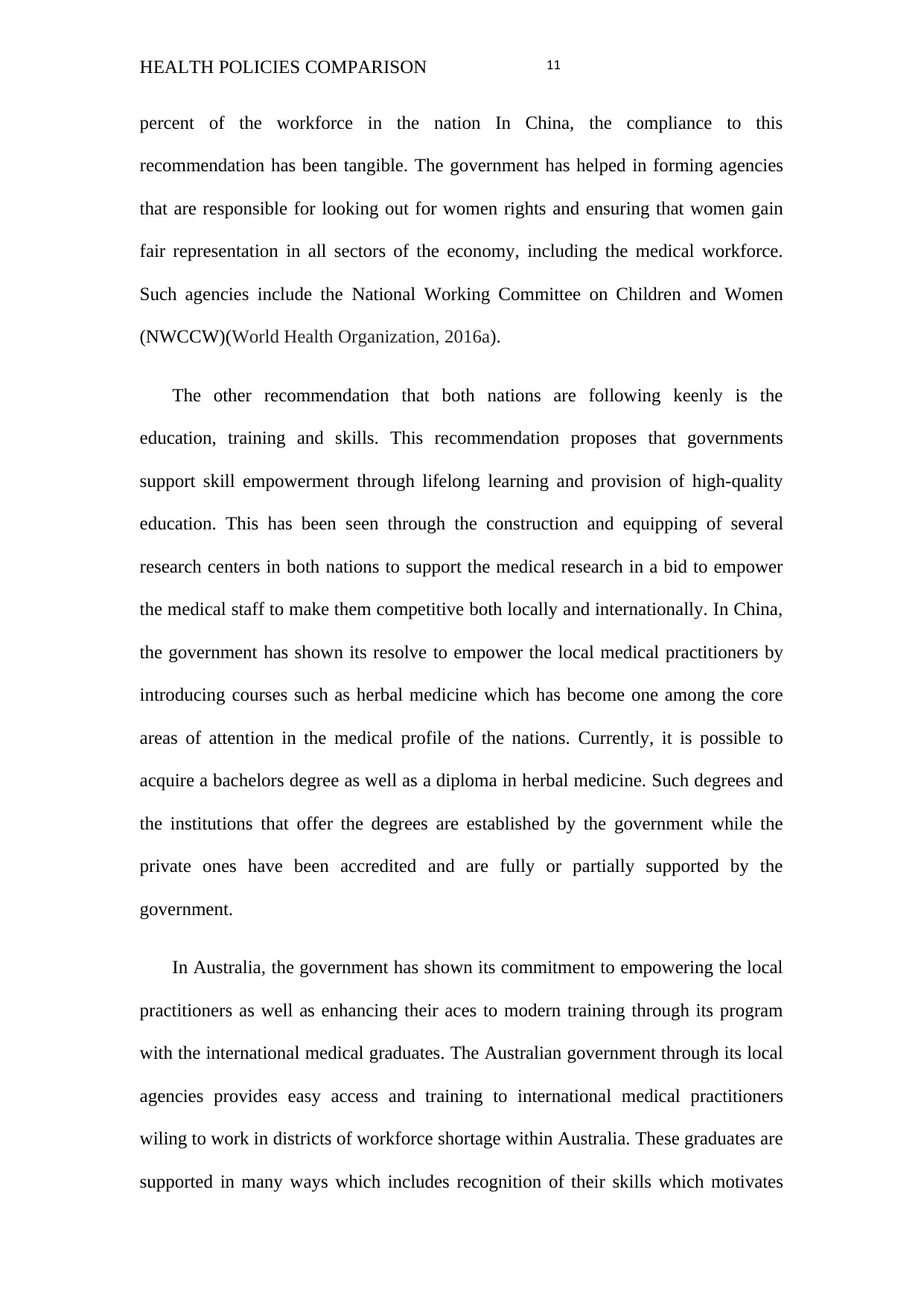
11HEALTH POLICIES COMPARISON
percent of the workforce in the nation In China, the compliance to this
recommendation has been tangible. The government has helped in forming agencies
that are responsible for looking out for women rights and ensuring that women gain
fair representation in all sectors of the economy, including the medical workforce.
Such agencies include the National Working Committee on Children and Women
(NWCCW)(World Health Organization, 2016a).
The other recommendation that both nations are following keenly is the
education, training and skills. This recommendation proposes that governments
support skill empowerment through lifelong learning and provision of high-quality
education. This has been seen through the construction and equipping of several
research centers in both nations to support the medical research in a bid to empower
the medical staff to make them competitive both locally and internationally. In China,
the government has shown its resolve to empower the local medical practitioners by
introducing courses such as herbal medicine which has become one among the core
areas of attention in the medical profile of the nations. Currently, it is possible to
acquire a bachelors degree as well as a diploma in herbal medicine. Such degrees and
the institutions that offer the degrees are established by the government while the
private ones have been accredited and are fully or partially supported by the
government.
In Australia, the government has shown its commitment to empowering the local
practitioners as well as enhancing their aces to modern training through its program
with the international medical graduates. The Australian government through its local
agencies provides easy access and training to international medical practitioners
wiling to work in districts of workforce shortage within Australia. These graduates are
supported in many ways which includes recognition of their skills which motivates
percent of the workforce in the nation In China, the compliance to this
recommendation has been tangible. The government has helped in forming agencies
that are responsible for looking out for women rights and ensuring that women gain
fair representation in all sectors of the economy, including the medical workforce.
Such agencies include the National Working Committee on Children and Women
(NWCCW)(World Health Organization, 2016a).
The other recommendation that both nations are following keenly is the
education, training and skills. This recommendation proposes that governments
support skill empowerment through lifelong learning and provision of high-quality
education. This has been seen through the construction and equipping of several
research centers in both nations to support the medical research in a bid to empower
the medical staff to make them competitive both locally and internationally. In China,
the government has shown its resolve to empower the local medical practitioners by
introducing courses such as herbal medicine which has become one among the core
areas of attention in the medical profile of the nations. Currently, it is possible to
acquire a bachelors degree as well as a diploma in herbal medicine. Such degrees and
the institutions that offer the degrees are established by the government while the
private ones have been accredited and are fully or partially supported by the
government.
In Australia, the government has shown its commitment to empowering the local
practitioners as well as enhancing their aces to modern training through its program
with the international medical graduates. The Australian government through its local
agencies provides easy access and training to international medical practitioners
wiling to work in districts of workforce shortage within Australia. These graduates are
supported in many ways which includes recognition of their skills which motivates
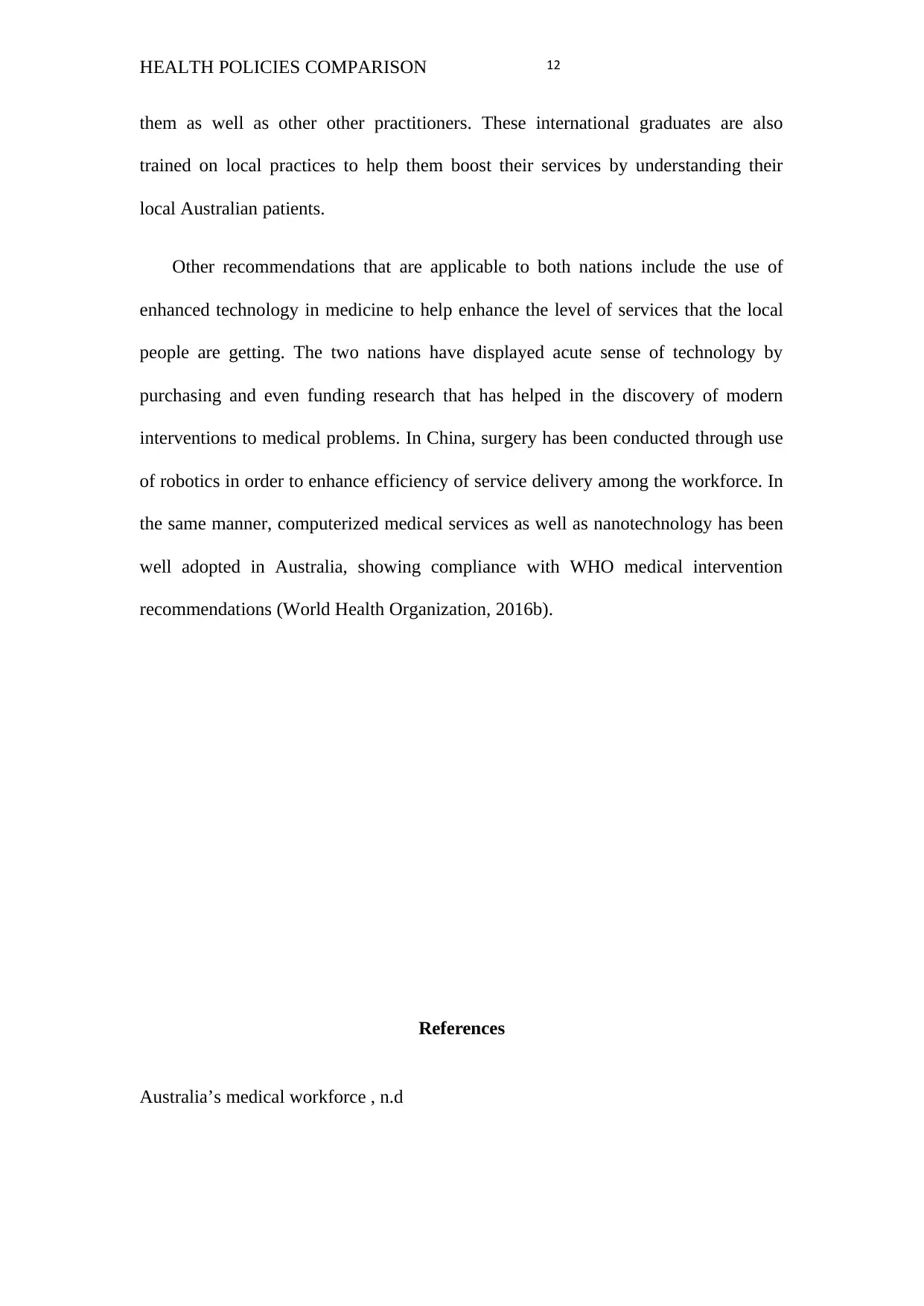
12HEALTH POLICIES COMPARISON
them as well as other other practitioners. These international graduates are also
trained on local practices to help them boost their services by understanding their
local Australian patients.
Other recommendations that are applicable to both nations include the use of
enhanced technology in medicine to help enhance the level of services that the local
people are getting. The two nations have displayed acute sense of technology by
purchasing and even funding research that has helped in the discovery of modern
interventions to medical problems. In China, surgery has been conducted through use
of robotics in order to enhance efficiency of service delivery among the workforce. In
the same manner, computerized medical services as well as nanotechnology has been
well adopted in Australia, showing compliance with WHO medical intervention
recommendations (World Health Organization, 2016b).
References
Australia’s medical workforce , n.d
them as well as other other practitioners. These international graduates are also
trained on local practices to help them boost their services by understanding their
local Australian patients.
Other recommendations that are applicable to both nations include the use of
enhanced technology in medicine to help enhance the level of services that the local
people are getting. The two nations have displayed acute sense of technology by
purchasing and even funding research that has helped in the discovery of modern
interventions to medical problems. In China, surgery has been conducted through use
of robotics in order to enhance efficiency of service delivery among the workforce. In
the same manner, computerized medical services as well as nanotechnology has been
well adopted in Australia, showing compliance with WHO medical intervention
recommendations (World Health Organization, 2016b).
References
Australia’s medical workforce , n.d
⊘ This is a preview!⊘
Do you want full access?
Subscribe today to unlock all pages.

Trusted by 1+ million students worldwide
1 out of 14
Related Documents
Your All-in-One AI-Powered Toolkit for Academic Success.
+13062052269
info@desklib.com
Available 24*7 on WhatsApp / Email
![[object Object]](/_next/static/media/star-bottom.7253800d.svg)
Unlock your academic potential
Copyright © 2020–2025 A2Z Services. All Rights Reserved. Developed and managed by ZUCOL.




